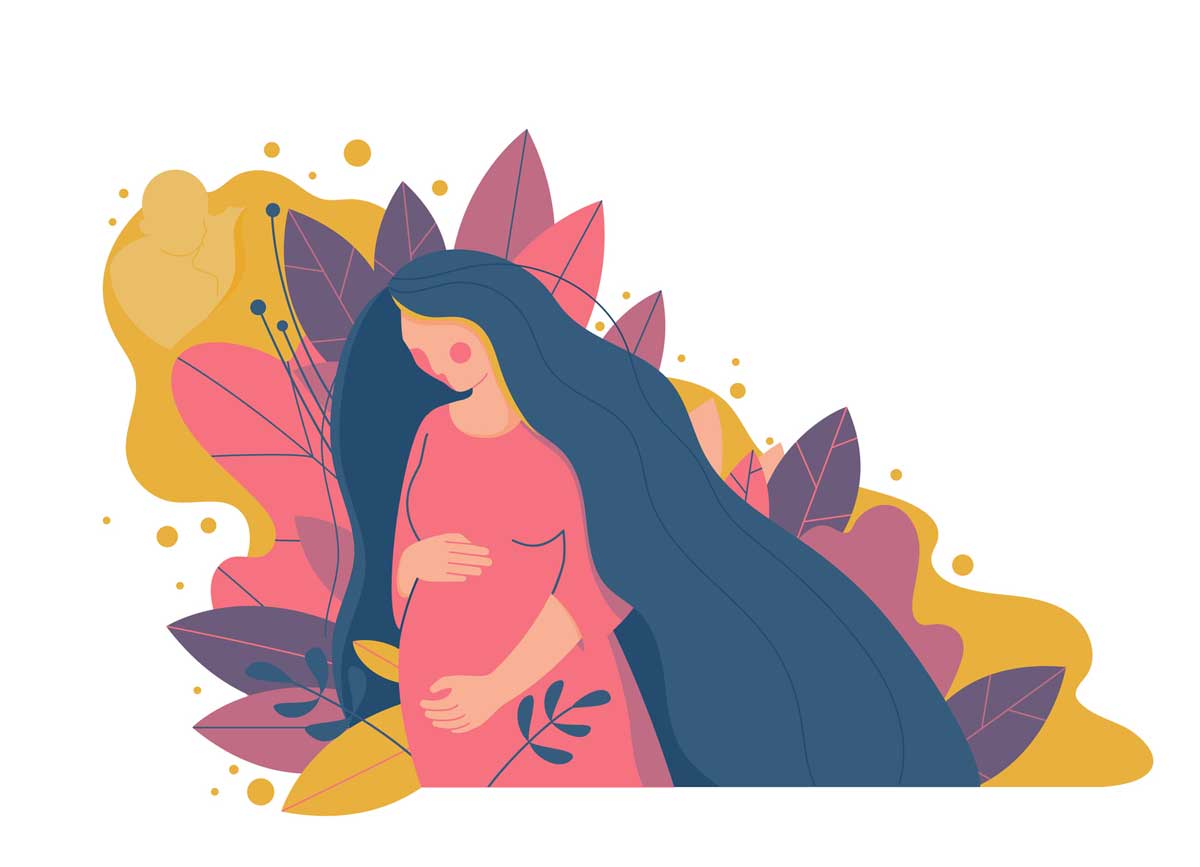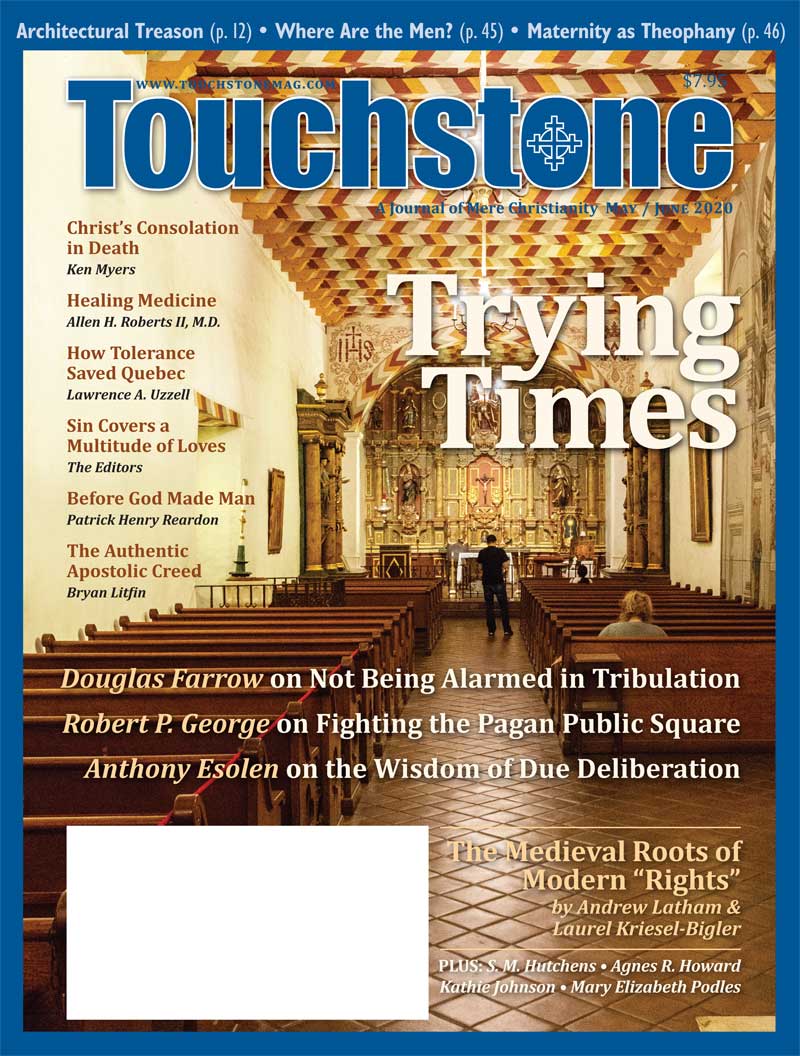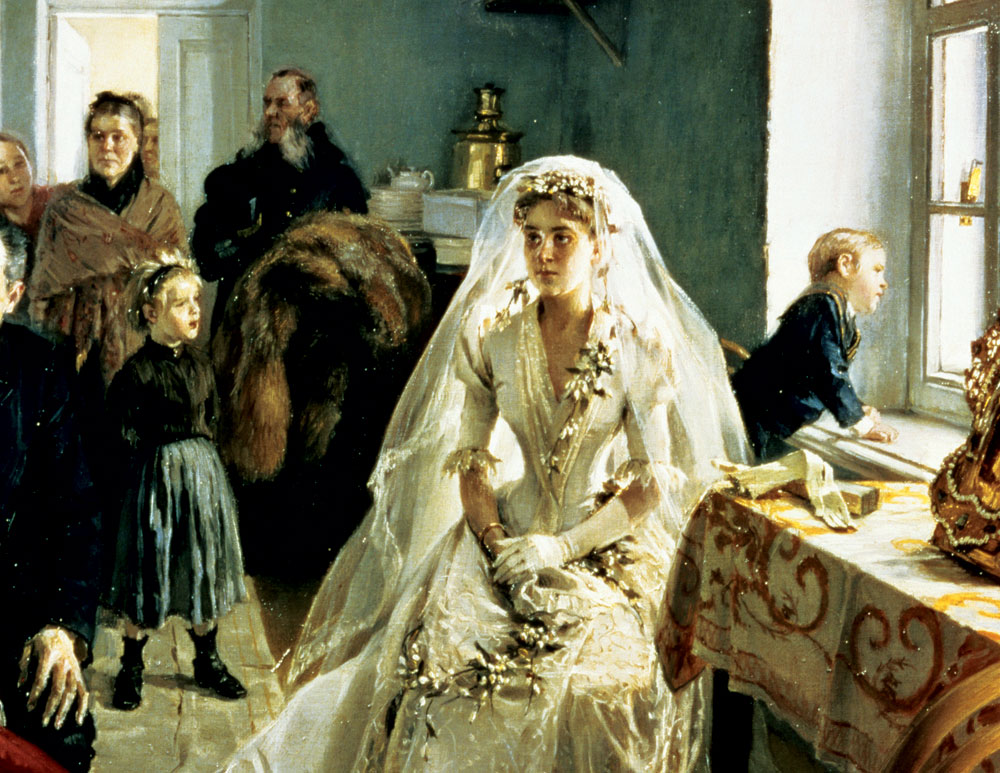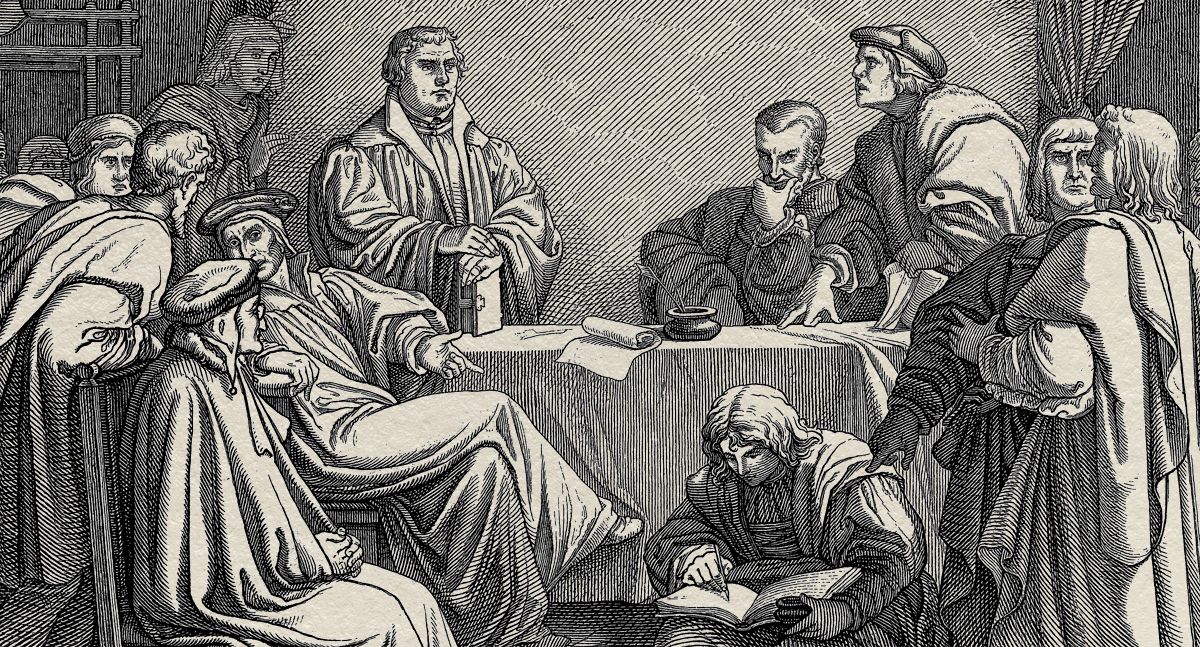Book Reviews
Maternity as Theophany
Maternal Body: A Theology of Incarnation from the Christian East by Carrie Frederick Frost
Paulist Press, 2019
(107 pages, $17.95, paperback)
Fertile Ground: A Pilgrimage Through Pregnancy by Laura S. Jansson
Ancient Faith Publishing, 2019
(318 pages, $18.95, paperback)
iewed by Agnes R. Howard
It may seem too obvious to be worth saying that pregnancy is a curious spiritual status: the condition of having two (or more) bodies, brains, and eternal souls in a space usually occupied by one. Just so, we might imagine that the best theological minds of the ages would have bent their exertions to puzzling this through. Instead, it turns out that wise treatment of this experience has been wanting until recently in current culture high and low, but also, disappointingly, in the theology and scholarship of the past. We have much to celebrate, then, in the nearly simultaneous arrival of two thoughtful books considering pregnancy from an Eastern Orthodox perspective.
By "we," I mean you, dear reader, since I will say even more vehemently than do these two able writers that the manner of human emergence into the world must not be a topic of interest only to new moms but to all of us. That includes all who have been brought into life by someone's efforts on their behalf, and all who believe in the Incarnation. Both Carrie Frederick Frost and Laura S. Jansson convey deep respect for ecclesiastical tradition even while acknowledging that it was a lack—a surprising, uncharacteristic lack—in their tradition that occasioned their scholarship on this topic. That response to a felt need, to compose a coherent, theologically inflected approach to childbearing rather than finding one at hand ready for recovery or practical application, determines the shape of both books, one formed by the writer's training as a theologian, the other by the writer's work as a doula.
Focus on Icons
Frost, professor of theology at St. Sophia Ukrainian Orthodox Seminary, was a graduate student at the University of Virginia when she discovered she was pregnant with triplets. She turned to her church tradition for counsel. She was disappointed to find that "motherhood is not a topic that has been taken up for deep theological reflection in the Orthodox tradition." She credits the Christian East with reverence "for pregnancy in general" but not in the particular, actual way it unfolds. Worse, when those privileged to study theology have turned to birth, they sometimes have allowed distaste or fear of the female body to overwhelm better judgment. Some Orthodox services and prayers positively do "not affirm motherhood as a vocation and did not affirm the maternal body."
Getting birth right is fundamental to a right theology of the body, so the task of her book "is just a matter of the maternal body being integrated into that theology." Frost thinks Orthodoxy may be well-positioned to help others appreciate the magnitude of maternity because of its rich understanding of the Incarnation, its veneration of icons recalling God's blessing of matter, and its recognition of the body as the "workshop" where humans grow closer to and more like God.
What Frost could not find in her church's theology she discovered in its practice. She looks to practice—with icons, prayers, hymns, and feasts—and finds resources on the good of childbearing. Icons are her focus, as they doubly demonstrate the significance of birth. The affirmation of matter implied in the process of birth underlies the use and veneration of icons altogether. "That Christians would use the materials of the created world to fashion images of their savior and saints makes perfect sense" to the author because "God took on matter in order to appear in the world of his creation." Mary, whom Christians regard as the Theotokos, the Birthgiver of God, is "at minimum, functionally foundational to the Incarnation, and she is also foundational to the icon . . . her maternal body led to iconography."
Frost organizes her book around the stages of childbearing: conception, pregnancy, birth, postpartum, and breastfeeding, choosing an icon for each to help explain physical and theological meaning. She remains grateful to Orthodoxy even when doctrine disappoints, deeming elements in it that slight motherhood as "out of alignment with the church's profound incarnational theology" rather than as revealing an anti-maternal stance inherent to Orthodoxy. Her chapters therefore take pains to "harmonize" them.
The first icon-focused chapter, on conception, features one depicting Mary's parents, Joachim and Anna, and blessing marital love and sexuality. Anna suffered infertility before Mary arrived. Here Frost criticizes some Orthodox handling of infertility, miscarriage, and stillbirth, with its suggestion that mothers are at fault, and Orthodox churches' failure to minister to people mourning these losses. The next chapter, on the short side, emphasizes the physical character of pregnancy as it studies the embrace of Mary and her cousin Elizabeth in an icon of the Visitation. For birth, icons depicting the Nativity vary, an opportunity for Frost to laud Orthodoxy's accommodation of different views and to urge women to look to Mary as a model. On breastfeeding, Frost marvels at how a mother's body becomes real food for nursing infants. She regrets that Orthodox icons, favoring a metaphorical take on Mary feeding her infant son, sometimes strangely display an anatomically incorrect breast.
Church Faults
Frost finds Orthodoxy most conspicuously "out of alignment" in the Churching ceremony that integrates postpartum women back into the community. Of ancient origin and practiced in both East and West and even by some Protestants after the Reformation, the "Churching of Women" mostly has fallen out of use in other branches of Christianity. The Orthodox retain it. The service marks the return of the woman into the life of the church weeks after she has given birth. Frost objects that this liturgy implies that sin inheres in the female body and in the physical process of birth. Churching's prayers for the new baby are exultant, but those over the mother start by asking God to "purify her" from "every sin and from every defilement," or filth.
While I understand Frost's objections, the Churching ceremony seems redeemable to me. On two other points, however, I would fault Christian practice more emphatically than Frost does, though not the Orthodox alone.
First, in spite of pro-life advocacy and esteem for mothers, many churches pay woefully little regard to pregnancy, taking it sentimentally or for granted altogether except in hard cases. Second, Frost regrets Orthodox prayers over miscarriage but could press this critique further. How could it be that a church tradition she names as possessing "a sophisticated theology of life after death" fails to offer "proper consolation on the occasion of the demise of the unborn"? Indeed, as Frost narrates, the very service for a mother mourning this loss blames her for killing and casting out her child. These two faults share a logical connection. The problem does not belong to the Orthodox alone. Underappreciation for what is happening in pregnancy and what a woman is doing enables mis-estimation of pregnancy loss.
Frost's book is commendably constructive. Maternity-related problems in Orthodoxy prompt her not to turn away from the church but to call others to help "repair and strengthen their tradition." Furthermore, as her book finds practice rather than theology more often in alignment with right views of the Incarnation, she encourages lay people, especially women, to contribute to this work: "The work on motherhood within the church needs to be done by mothers." Lay people have important roles in enlivening liturgical practice, and mothers have insights worthily shared.
I admit feeling, though Frost may not, a twinge of weariness at the suggestion that mothers rehabilitate churches' practices devoted to childbearing. Do they have to do this, too? It is good that women now can contribute to a theological tradition in which they had been held peripheral. But if birth only gains emphasis because women are interested in it, the significance of it may not reach the audience Frost intends.
Giving Pregnancy Its Due
Uncannily well fitted to answer to Frost's call, Jansson takes up the challenge of doing the work on motherhood. A mother and a practicing doula, Jansson has extensive acquaintance with the concerns Frost raises and is an Orthodox Christian. Where Frost chooses icons to organize her meditations on maternity, Jansson reaches for the metaphor of pilgrimage. Her book comes in at a full-term 37 chapters, with a rest stop for each week of pregnancy.
The form and content of Jansson's book themselves help signal deficiencies in common prenatal literature. Many books about pregnancy are merely medical advice put in laypersons' terms, itemizing chronological developments and self-care prescriptions, utterly missing the import of the event; Jansson adopts this week-by-week convention not to give health advice but to present topics in manageable parcels.
Most books about motherhood pass too quickly over pregnancy to dwell on birth and babyhood. This is true even of very good books. Even Frost passes over pregnancy rather rapidly. Writing in this genre, Jansson gives pregnancy its due, extending reflection and counsel over the whole nine months. To her credit, the book almost entirely avoids treating pregnancy as a sort of boot camp for the rigors of motherhood—a usual approach that not only belittles bearing but also implies that others who miss this prep course, like fathers and adoptive parents, are disadvantaged.
Her assessment of pregnancy is right, and profound. The act of carrying and nurturing a baby into life is every bit as ample, significant, and astonishing as she purports. She describes the pregnant woman as a "co-creator with God," an "eschatological creature," her belly "a place where the eternal victory of life over death is being waged in quiet secrecy," and, contemplating an icon of the Visitation, birth as a kind of "theophany." The stakes really are this high, its occurrence in our midst that thrilling. Not a stint of passive waiting around for the belly to expand and a baby to appear, pregnancy can be an active period of doing and becoming. For a woman so involved, as with Mary's agreement to the promise of the Annunciation, the process requires an ongoing assent.
Jansson requests that we take pregnancy seriously as a kind of revelation, both to the mother and through the mother, as her body and actions show all of us something about the goodness and creative power of God. She approaches the phenomenon from the inside, acknowledging what the body does and how it feels, then surveys cultural responses to these things and attempts to tell what they mean. The first part of that is fairly standard for pregnancy books—discussion of nausea, heartburn, constipation, quickening, swollen ankles—but what lightweight, what-to-expect books configure as the tedium or inconvenience of pregnancy, she renders instead as maternal exercise of charity and hospitality. She is right to do so.
Contrary to pregnancy fashions, she takes lightly no part of carrying in one's body an unknown, unique person not yet seen on the earth but requiring care and reflection in order to exist. For instance, on the vagaries of eating while pregnant, Jansson reaches for ascesis as a way to explain the moral significance of what women do. Like the disciplines monks use, pregnancy encourages a kind of "professional asceticism," a self-denial and self-emptying to ready oneself for God's gifts and to position oneself to give generously to another.
Some of Jansson's language about the goods of pregnancy are familiar from other treatments. Her description of hospitality and charity in pregnancy echo Frost's discussion in parts. This should neither surprise nor disturb us. Such writing constitutes agreement about what pregnancy is, rather than a writer's sport with originality in describing what a pregnant woman is doing.
Theological Considerations
Having assessed the physical or experiential quality of aspects of childbearing, Jansson assays theological readings of them, from lay status as a woman informed by practice and church tradition. Though some of her reflections might be appreciated by any woman ever awed by the feel of a baby kicking in utero, some is explicitly Orthodox. She aims here not only to excavate wisdom on pregnancy hidden under bushels of dogmatic tomes, but to show that Orthodox Christianity specifically has wisdom to bring.
She calls the expectant mother a "living icon of the Holy Trinity." She invites readers to see in the weakness of the pregnant body an opportunity to imitate Christ. She wants us, when gazing at the navel, to be reminded of our lineage with the saints. She compares the encircling of woman and child to perichoresis, the term that describes the encompassing movement of Father, Son, and Holy Spirit. If pregnancy is the reception of blessing, the practice of spiritual disciplines, and the wonder of becoming, then birth, too, is more than just separation of one body from another: "The Labor and Delivery wing of the local hospital becomes the site of holy mysteries, a place to approach with awe and trembling."
Though they share many resonances in theological views on pregnancy, the contrast between Frost's and Jansson's interpretations of Churching is instructive. Frost cringes at the rite and its antique, misleading suggestions that women's bodies and birth are somehow corrupted. Jansson, in contrast, points proudly to Churching as a place where the Orthodox do better than other Christian traditions in honoring motherhood. Frost is reasonable to regret the suggestion that childbirth pollutes women, and Jansson may let that purity language pass with too little objection.
I find nothing to commend about dropping Churching altogether in the churches that have done it. Which is worse: having a churchly occasion whose liturgy still sounds embarrassed about the female body, or having no liturgy at all? Most Christians have no liturgy for this at all. As Frost maintains throughout her book, theologians' near thorough lack of interest in pregnancy and birth represents a lost opportunity to offer godly wisdom about an experience crucial to human life. Some (other?) ceremony is needed to celebrate the strength and joy of a woman who has gone through birth and has come back with a new addition to the Body of Christ.
When culture or church comes up empty in interpreting pregnancy, Jansson looks to her work as a doula and the midwifery traditions that work shares. That perspective informs consideration of birth elements sometimes controversial, like induction, the location of and participants in delivery, the use of synthetic hormones to speed the process, and the use of anesthesia to remove pain from it, and these matters, too, get theological treatment. As is almost obligatory in a book treating birth theologically, Jansson takes up the question of pain as Eve's curse and renders the struggle of birth a toil rather than a punishment God assigned to women.
While I mostly lean in her direction on birth decisions, it may be overstatement to diagnose labor induction as Gnosticism: "Gnostic dualism would disdain birth as a mechanical event rather than part of a delicate and mysterious dance of bodies and souls." Pushing too hard in this direction, though, better suits the tone of this book than the occasional pages where the personal or anecdotal tilts to the sentimental. Broaching the character of birth as a "thin place," for instance, Jansson gives play to her imagination while in a cottage on the River Tweed:
With my supersensitive pregnancy nose, I could smell the blood of former centuries that had soaked this earth as the border was pushed back and forth. And for a moment I could sense just how it felt to be the pregnant woman who lived here in those days, a toddler on her hip and a husband away in the fields, breathing 'Lord have mercy' as she saw the invaders ride up.
Not a Narrow Female Concern
The weakness of this insightful book may be structural features that cut against the profundity and solidity of what it attempts. To be sure, the book takes on so much that the task of fitting all of it into one volume would be a challenge under any circumstances. I do not interpret all elements of pregnancy the way Jansson does, but I agree with her that they all deserve interpretation. I understand what she intends by the "pilgrimage" title, although the metaphor recedes from consideration. I understand why Jansson partitioned her meditations into 37 parts, though at points some meditations would be better divided thematically than as this your-pregnancy-week-by-week format
dictates.
That is my primary objection to the book. That week-by-week ordering, plus the illustrations and introductory note to the mother-to-be and the thought questions appended for each chapter, suggest that this material is mostly addressed to a woman with hand resting gently over a rising belly. But I don't believe that. I don't think Jansson believes that.
If it is true that the pregnant woman is a visible reminder of the love and creative power of God, then books handling these matters deserve consideration by all adults who care how things stand between God and humanity. In the midst of their journeys of life, both Frost and Jansson came to confront a situation, pregnancy, which they recognized as tremendous. Because trusted cultural institutions minimized what they knew to be magnificent, they not only had to figure out for themselves the magnitude of the thing, but also to explain it to incredulous bystanders.
Birth is not a narrow female concern. For the Orthodox, maternity accentuates the good of creation and of new life called to draw near to God. For the church more broadly, pregnancy and birth illuminate the very basis of the Incarnation, God's blessing of our physical existence, the origin of responsibility for embodiment. For the world, pregnancy and birth highlight our obligations to one another, to the need for generosity and physical presence in making life possible at all.
Agnes R. Howard is adjunct assistant professor of humanities in Christ College, Valparaiso University, Valparaiso, Indiana, and author of Showing: What Pregnancy Tells Us about Being Human (Eerdmans, 2020).
subscription options
Order
Print/Online Subscription

Get six issues (one year) of Touchstone PLUS full online access including pdf downloads for only $39.95. That's only $3.34 per month!
Order
Online Only
Subscription

Get a one-year full-access subscription to the Touchstone online archives for only $19.95. That's only $1.66 per month!
bulk subscriptions
Order Touchstone subscriptions in bulk and save $10 per sub! Each subscription includes 6 issues of Touchstone plus full online access to touchstonemag.com—including archives, videos, and pdf downloads of recent issues for only $29.95 each! Great for churches or study groups.
Transactions will be processed on a secure server.
more on Family from the online archives
more from the online archives
calling all readers
Please Donate
"There are magazines worth reading but few worth saving . . . Touchstone is just such a magazine."
—Alice von Hildebrand
"Here we do not concede one square millimeter of territory to falsehood, folly, contemporary sentimentality, or fashion. We speak the truth, and let God be our judge. . . . Touchstone is the one committedly Christian conservative journal."
—Anthony Esolen, Touchstone senior editor













